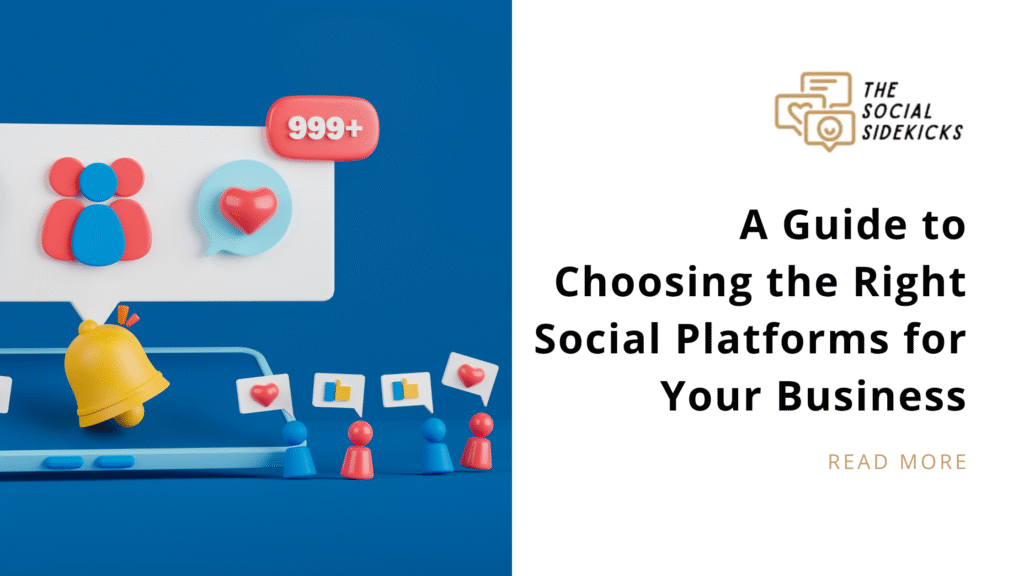
- Understanding your business goals and audience behavior is the foundation of an effective social platform strategy.
- Each platform offers unique strengths; aligning them with your content style and capacity creates more authentic and consistent engagement.
- The Social Sidekicks supports brands in building meaningful, sustainable social media strategies that match business goals with the right platforms.
Choosing social media platforms can feel like standing at a crossroads with multiple signs pointing in different directions. Each platform claims to be essential. Advice from marketing experts sometimes overlaps or contradicts itself. And new apps seem to appear overnight, making it difficult to know where to focus your attention.
Here, we will help you make intentional, informed choices based on your business goals, your audience, and your ability to create meaningful content. Whether you are just starting to build a presence or reevaluating what is working, you will find clarity here.
Begin With a Clear Purpose
Your platform choices should reflect what you want to accomplish. Goals that lack clarity often result in scattered content, inconsistent branding, and low engagement. Start by identifying your core objectives.
Ask yourself:
Are you trying to increase brand visibility?
Do you want to create a community among existing customers?
Are you focused on lead generation or direct sales?
Do you want to educate your audience about your services?
When you know the purpose of your presence, every choice becomes easier. You can prioritize the platforms where your goals align with the native strengths of the channel. For example, a business focused on recruitment and thought leadership may find more traction on LinkedIn, while a retail brand might build stronger engagement on Instagram or Pinterest.
Purpose acts as your filter. It helps you say yes to platforms that make sense and say no to those that drain your time without moving you forward.
Know Your Audience, Not Just Their Demographics
It is easy to find age breakdowns and gender splits for platforms. These can offer a starting point, but they are far from enough. Two people in the same demographic might behave completely differently online.
What matters more is understanding behavior, needs, and preferences. What does your audience care about when they are not thinking about your business? Where do they spend their time scrolling or searching? What kind of content are they drawn to?
People go to different platforms for different reasons. Someone might use Facebook to stay in touch with family, scroll through Instagram for design inspiration, and open LinkedIn to follow industry news. Understanding these patterns gives you insight into when and where to show up.
Look beyond the numbers and try to observe tone, style, and interaction preferences. Watch how your competitors’ audiences engage. Survey your existing customers about where they spend time. Notice where conversations are happening, and listen to what people are saying. These are not statistics—they are signals.
Align Platforms With Your Strengths
Every social channel rewards certain types of content. Choosing where to invest your energy means being honest about your own capacity and communication style.
If your business naturally produces strong visuals, think product photography, interior design, fashion, or food, then platforms like Instagram or Pinterest might be a natural fit. These platforms reward aesthetic consistency, short captions, and shareable content.
If your strength lies in thoughtful writing, insight, or storytelling, consider LinkedIn, blogs, or long-form captions on Facebook. These channels give more space for explanation and are appreciated by audiences looking for depth.
Short-form video is highly favored on platforms like TikTok, Instagram Reels, and YouTube Shorts. This content demands energy, fast editing, and a clear hook. Businesses that thrive in this format are often willing to experiment and embrace informality.
The best content does not feel forced. If you are trying to master a style that is completely outside your natural rhythm, it will take more effort, more time, and often result in lower returns. Choose platforms where your communication style feels sustainable and true to your brand voice.
Choose Fewer Platforms and Show Up Fully
There is a common myth that being on every platform increases visibility. In reality, being present without being consistent often leads to silence. It is better to be fully engaged in one or two places than to stretch your energy across five channels and post sporadically.
Start small. Identify one or two platforms that align with your goals, fit your audience’s behavior, and match your strengths. Focus your energy there. Build routines. Test content formats. Learn what resonates. As you build traction, you can consider adding new platforms intentionally.
This approach helps prevent overwhelm. It also creates a stronger sense of connection with your audience. When people know where to find you and what to expect, trust builds faster.
There is also a technical benefit. Algorithms tend to favor accounts that engage regularly. A strong presence on one platform often outperforms a weak presence across many.

Understand the Role of Each Platform
Choosing the right platform also means understanding what each one offers and how your audience uses it.
Instagram is highly visual and works well for lifestyle brands, products, creative services, and personal storytelling. It supports both broad brand awareness and deeper community building, especially through features like Stories and Reels.
Facebook remains valuable for certain industries, especially those that benefit from community groups, local engagement, and long-form discussion. It can be an effective customer service channel and is still widely used by audiences aged 30 and older.
LinkedIn is best for B2B networking, industry leadership, recruiting, and professional development. Its audience is more open to business content, advice, and case studies. High-quality writing and consistency matter here.
TikTok rewards creativity, humor, and trend participation. It is one of the fastest-growing platforms, especially for Gen Z and younger millennials. Brands that thrive here often have a playful or informal tone and are willing to experiment.
Pinterest acts more like a search engine than a social platform. It is perfect for content that provides inspiration, ideas, and planning. Blog links, product pins, and infographics perform well, particularly in niches like home improvement, fashion, and personal development.
X (Twitter) is fast-moving and dialogue-based. It works well for real-time updates, commentary, and building voice. Brands that are responsive and witty can grow quickly, though it requires consistent attention.
The goal is not to chase popularity. It is to identify what role each platform could realistically play in your communication strategy. Some platforms will serve as primary channels. Others might act as supportive spaces.
Plan for Content Creation and Capacity
Your platform choices must be grounded in what you can realistically maintain. Social media is not a set-it-and-forget-it task. It requires time, attention, and a feedback loop.
Think carefully about how much content you can create without rushing. Do you have photos, videos, or written content available? Do you have time to respond to comments or DMs? Are you comfortable filming yourself, or would you prefer to write?
Your answers shape not only the platform but also the format and posting frequency. For example, if you are a small team and cannot film regularly, prioritizing TikTok may cause stress. If you enjoy writing but cannot take high-quality photos, Instagram might be more of a challenge.
Content planning is a skill you can build over time, but your platform decisions should reflect your current bandwidth. Choose platforms that set you up for sustainable success.
Evaluate Performance Based on Strategy
Once your platforms are active, you need to track results. But measuring success is not as simple as looking at likes or followers.
Ask yourself whether the platform is helping you meet the original purpose. Are you getting inquiries? Are people staying on your site longer? Are conversations turning into relationships?
Good performance indicators include:
- Engagement rate relative to reach
- Click-throughs to your website or landing pages
- Time spent on your content
- Shares and saves (indicators of value)
- Comments that show genuine interest or connection
Over time, you will see patterns. Some platforms will bring in more volume. Others might drive more qualified leads. Both have value. Understanding your own performance data allows you to refine your strategy rather than guessing.
Allow for Reassessment
As your business evolves, so will your social presence. You may enter a new market, launch new services, or change your brand tone. These shifts may warrant a new look at which platforms still make sense.
Set aside time each quarter or at least twice a year to review what is working. Do this with curiosity, not judgment. Metrics can offer guidance, but so can your own energy. If a platform drains your team or feels disconnected from your brand, it may be time to scale back or step away.
Equally, new opportunities may open up. Perhaps you now have the capacity to launch short-form video, or your audience has started asking for more behind-the-scenes content. Stay open, but stay focused. Growth comes from depth, not from trying to do everything at once.
Social Media as Relationship, Not Just Reach
The most successful brands on social media are not the loudest. They are the most connected.
People want to feel something when they interact with a business. They want to laugh, learn, be heard, or be inspired. They want to know that someone is listening and that there is a human being behind the posts.
Your platforms are simply the place where this happens. The real work is the relationship.
This is why choosing the right platform matters so much. It is not a technical decision. It is a decision about where you want to connect, build trust, and grow.
If you keep that purpose at the center, you will always know where to begin and when to pivot.
Let our team at The Social Sidekicks help you build a presence that matches your voice, values, and goals, platform by platform, with a strategy that suits you well. Contact us today.
